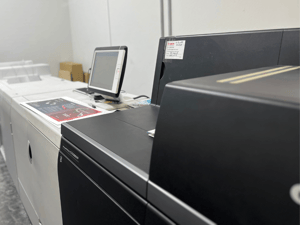Let’s face it: in some circles, the thought of printing materials for a marketing campaign in 2023 is considered quaint, if not downright old fashioned. Digital marketers can’t possibly conceive of the value of print; as far as they’re concerned, why spend the time and money to manufacture something when they can create web-based, e-mail, and mobile campaigns quickly, easily and cost effectively?

While it’s true that the concept of print does sound distinctly “old school,” it—like vinyl LPs—is gaining a new level of coolness and credibility. Thanks to steadily improving on-demand printing capabilities, production times have dropped to just days or even hours, and prices are now quite reasonable. As for quality, digital web-to-print output is every bit as good today as offset printing.
Print is also a great medium for supporting digital channels such as web and e-mail. Integrating printed materials with your larger marketing campaign helps you reach a broader audience while reinforcing the overall message—a real one-two punch.
When to Consider Print
In what situations might printed assets be more effective than digital assets for a marketing campaign? Actually, there are several. Here are a few examples:
1. When you’re planning an e-mail campaign but don’t have an accurate (or complete) list of e-mail addresses.
Individual e-mail addresses can sometimes be hard to find. But everyone (or at least every business) has a physical mailing address, and those are relatively easy to find. Using a printed direct mail piece to supplement an e-mail campaign can help you reach a wider audience. In fact, you can even go one step further and use the printed piece to drive recipients to a website where you can capture their latest contact information, including an up-to-date e-mail address. As long as you have a compelling offer, it shouldn’t be difficult to get them to do this.
 2. When you want your message to be memorable.
2. When you want your message to be memorable.
No matter how clever a subject line is, unsolicited e-mail is often viewed with suspicion and frequently relegated to the trash bin without ever being opened. An unusual or intriguing mail piece, on the other hand, is a welcome change from the daily e-mail onslaught. Printed materials can be held and examined, providing a tangible representation of your brand. Plus, studies have shown that people are more likely to remember information they have read on paper rather than on a screen. If your design, format, and production values are exceptional (or at least interesting), it will get noticed.
3. When digital communications can’t quite convey the desired mood.
As a two-dimensional medium, digital communication has its limitations. Printed materials, on the other hand, can be more engaging through the use of creative and eye-catching designs that draw attention to your message. Whatever technological advantages that digital once held have been largely erased; print technology has advanced to the point that each piece can be customized and personalized to each individual recipient, making them feel more valued and engaged. Using variable data printing (VDP), which employs a database tied to a printed template, text, photos and other visuals can be changed as needed to reflect the individual. The days of cookie-cutter printing are over; marketers can now print materials that are personalized and therefore more effective.
4. When you want to reach a broader audience.
Digital marketing can reach anyone with a computer or smart device. Printed materials can reach everyone, including those who don’t have access to digital channels. This is where it’s important to know your target demographic: if your audience is older or includes those who may not be terribly tech savvy, printed materials may be a more effective way to reach them. Additionally, printed materials can be used in a variety of settings, including mail campaigns, trade shows, conferences, and other live events. You get a bigger bang for your buck.
5. When credibility matters.
Simply put, printed materials convey a level of credibility the digital marketing does not by demonstrating an investment and commitment to quality.
Clearly, despite common assumptions, print is not dead. Depending on your objectives, print may be the preferred medium. People are more likely to remember information they read on paper vs. on a screen. Printing technology has also become more flexible and cost-effective, making it a viable and economical option for businesses of all sizes. Even for those committed to digital technology, print can offer a power complement that allows organizations using a combination of both to reach a far wider audience, which in turn helps them meet their marketing objectives.
Give print a second look. You’ll be surprised how far it’s come.





